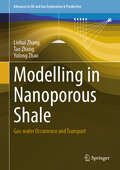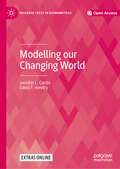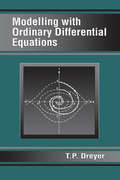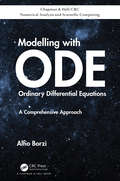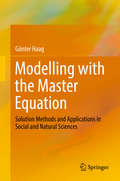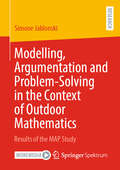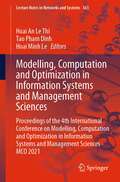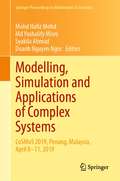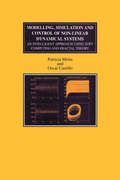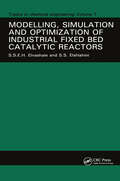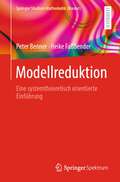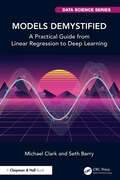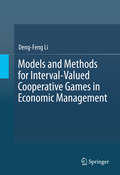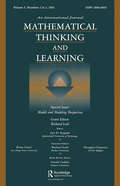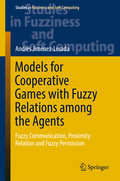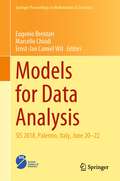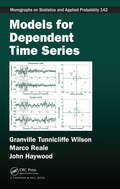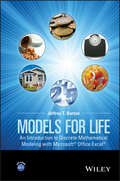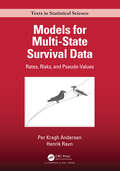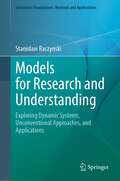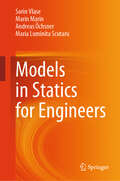- Table View
- List View
Modelling in Nanoporous Shale: Gas-water Occurrence and Transport (Advances in Oil and Gas Exploration & Production)
by Tao Zhang Liehui Zhang Yulong ZhaoThis book addresses the problems involved in the modelling and simulation of shale gas reservoirs at pore scale, and details recent advances in the field. It presents the construction of simulation methods, mainly using the lattice Boltzmann method (LBM), that describe sorption, flow, and transport in nanoporous shale with some case studies. This book highlights the nanoscale effects, ascribed to the large surface-to-volume ratio, on fluids occurrence and transport physics. It discusses some interesting phenomena occurs at nanoporous shale, such as absorbed water film, water condensation, sorption hysteresis, surface excess adsorption, Knudsen diffusion, surface diffusion, structural fluid density, no-slip boundary, etc. The key techniques and methods introduced in this book provide the basis for accurate prediction of gas-well productivity. The basic principles and modeling methods are also relevant to many other nanoporous applications in science and engineering. The book aims to provide a valuable reference resource for researchers and professional scientists and engineers working on shale gas development and nanoporous media research.
Modelling our Changing World (Palgrave Texts in Econometrics)
by David F. Hendry Jennifer L. CastleThis open access book focuses on the concepts, tools and techniques needed to successfully model ever-changing time-series data. It emphasizes the need for general models to account for the complexities of the modern world and how these can be applied to a range of issues facing Earth, from modelling volcanic eruptions, carbon dioxide emissions and global temperatures, to modelling unemployment rates, wage inflation and population growth.Except where otherwise noted, this book is licensed under a Creative Commons Attribution 4.0 International License. To view a copy of this licence, visit http://creativecommons.org/licenses/by/4.0.
Modelling with Ordinary Differential Equations
by T.P. DreyerModelling with Ordinary Differential Equations integrates standard material from an elementary course on ordinary differential equations with the skills of mathematical modeling in a number of diverse real-world situations. Each situation highlights a different aspect of the theory or modeling. Carefully selected exercises and projects present excellent opportunities for tutorial sessions and self-study.This text/reference addresses common types of first order ordinary differential equations and the basic theory of linear second order equations with constant coefficients. It also explores the elementary theory of systems of differential equations, Laplace transforms, and numerical solutions. Theorems on the existence and uniqueness of solutions are a central feature. Topics such as curve fitting, time-delay equations, and phase plane diagrams are introduced. The book includes algorithms for computer programs as an integral part of the answer-finding process. Professionals and students in the social and biological sciences, as well as those in physics and mathematics will find this text/reference indispensable for self-study.
Modelling with Ordinary Differential Equations: A Comprehensive Approach (Chapman & Hall/CRC Numerical Analysis and Scientific Computing Series)
by Alfio BorzìModelling with Ordinary Differential Equations: A Comprehensive Approach aims to provide a broad and self-contained introduction to the mathematical tools necessary to investigate and apply ODE models. The book starts by establishing the existence of solutions in various settings and analysing their stability properties. The next step is to illustrate modelling issues arising in the calculus of variation and optimal control theory that are of interest in many applications. This discussion is continued with an introduction to inverse problems governed by ODE models and to differential games. The book is completed with an illustration of stochastic differential equations and the development of neural networks to solve ODE systems. Many numerical methods are presented to solve the classes of problems discussed in this book. Features: Provides insight into rigorous mathematical issues concerning various topics, while discussing many different models of interest in different disciplines (biology, chemistry, economics, medicine, physics, social sciences, etc.) Suitable for undergraduate and graduate students and as an introduction for researchers in engineering and the sciences Accompanied by codes which allow the reader to apply the numerical methods discussed in this book in those cases where analytical solutions are not available
Modelling with the Master Equation: Solution Methods and Applications in Social and Natural Sciences
by Günter HaagThis book presents the theory and practical applications of the Master equation approach, which provides a powerful general framework for model building in a variety of disciplines. The aim of the book is to not only highlight different mathematical solution methods, but also reveal their potential by means of practical examples.Part I of the book, which can be used as a toolbox, introduces selected statistical fundamentals and solution methods for the Master equation. In Part II and Part III, the Master equation approach is applied to important applications in the natural and social sciences.The case studies presented mainly hail from the social sciences, including urban and regional dynamics, population dynamics, dynamic decision theory, opinion formation and traffic dynamics; however, some applications from physics and chemistry are treated as well, underlining the interdisciplinary modelling potential of the Master equation approach. Drawing upon the author’s extensive teaching and research experience and consulting work, the book offers a valuable guide for researchers, graduate students and professionals alike.
Modelling, Analysis, and Control of Networked Dynamical Systems (Systems & Control: Foundations & Applications)
by Karl H. Johansson Ziyang Meng Tao YangThis monograph provides a comprehensive exploration of new tools for modelling, analysis, and control of networked dynamical systems. Expanding on the authors’ previous work, this volume highlights how local exchange of information and cooperation among neighboring agents can lead to emergent global behaviors in a given networked dynamical system.Divided into four sections, the first part of the book begins with some preliminaries and the general networked dynamical model that is used throughout the rest of the book. The second part focuses on synchronization of networked dynamical systems, synchronization with non-expansive dynamics, periodic solutions of networked dynamical systems, and modulus consensus of cooperative-antagonistic networks. In the third section, the authors solve control problems with input constraint, large delays, and heterogeneous dynamics. The final section of the book is devoted to applications, studying control problems of spacecraft formation flying, multi-robot rendezvous, and energy resource coordination of power networks.Modelling, Analysis, and Control of Networked Dynamical Systems will appeal to researchers and graduate students interested in control theory and its applications, particularly those working in networked control systems, multi-agent systems, and cyber-physical systems. This volume can also be used in advanced undergraduate and graduate courses on networked control systems and multi-agent systems.
Modelling, Argumentation and Problem-Solving in the Context of Outdoor Mathematics: Results of the MAP Study
by Simone JablonskiMathematics outside the classroom – this work examines the characteristics of outdoor mathematics in more detail. Leaving the classroom to discover mathematics in the environment has several potential benefits for mathematics, e.g. the acquisition of skills and competencies. By means of an empirical study with secondary school students, the competencies of modelling, argumentation and problem-solving are taken into consideration. Therefore, the work outdoors at real objects is compared to the work inside the classroom. Similarities and differences are reported from three different perspectives: an observation perspective, the students&’ perceptions perspective and a digital enrichment perspective. The results contribute to the question of what characterizes the work outdoors at real objects.
Modelling, Computation and Optimization in Information Systems and Management Sciences: Proceedings of the 4th International Conference on Modelling, Computation and Optimization in Information Systems and Management Sciences - MCO 2021 (Lecture Notes in Networks and Systems #363)
by Hoai An Le Thi Hoai Minh Le Tao Pham DinhThe proceedings consist of 34 papers which have been submitted to the 4th international conference on Modelling, Computation & Optimization in Information Systems and Management Science (MCO 2021) held on 11-13 December, 2021 at Hanoi, Vietnam. The book is composed of 3 parts: Optimization of complex systems - models and methods, Machine Learning - algorithms and applications, and Cryptography. All chapters in the books discuss theoretical and algorithmic as well as practical issues connected with modelling, computation & optimization in Information Systems and Management Science. Researchers and practitioners in related areas will find a wealth of inspiring ideas and useful tools & techniques for their own work.
Modelling, Simulation and Applications of Complex Systems: CoSMoS 2019, Penang, Malaysia, April 8-11, 2019 (Springer Proceedings in Mathematics & Statistics #359)
by Mohd Hafiz Mohd Md Yushalify Misro Syakila Ahmad Doanh Nguyen NgocThis book discusses the latest progresses and developments on complex systems research and intends to give an exposure to prospective readers about the theoretical and practical aspects of mathematical modelling, numerical simulation and agent-based modelling frameworks. The main purpose of this book is to emphasize a unified approach to complex systems analysis, which goes beyond to examine complicated phenomena of numerous real-life systems; this is done by investigating a huge number of components that interact with each other at different (microscopic and macroscopic) scales; new insights and emergent collective behaviours can evolve from the interactions between individual components and also with their environments. These tools and concepts permit us to better understand the patterns of various real-life systems and help us to comprehend the mechanisms behind which distinct factors shaping some complex systems phenomena being influenced.This book is published in conjunction with the International Workshop on Complex Systems Modelling & Simulation 2019 (CoSMoS 2019): IoT & Big Data Integration. This international event was held at the Universiti Sains Malaysia Main Campus, Penang, Malaysia, from 8 to 11 April 2019. This book appeals to readers interested in complex systems research and other related areas such as mathematical modelling, numerical simulation and agent-based modelling frameworks.
Modelling, Simulation and Control of Non-linear Dynamical Systems: An Intelligent Approach Using Soft Computing and Fractal Theory
by Oscar Castillo Patricia MelinThese authors use soft computing techniques and fractal theory in this new approach to mathematical modeling, simulation and control of complexion-linear dynamical systems. First, a new fuzzy-fractal approach to automated mathematical modeling of non-linear dynamical systems is presented. It is illustrated with examples on the PROLOG programming la
Modelling, Simulation and Optimization of Industrial Fixed Bed Catalytic Reactors
by S.S.E.H. ElnashaieIn the last two decades impressive advances have been made toward the understanding and quantitative description of the kinetics. Despite these advances, however, the use of mathematical modelling of gas-solid catalytic reactors in industry is still limited. By consolidating progress in the understanding of catalytic processes, this book applies these fundamental advances to the development of models for design, simulation and optimization of industrial reactors. Paying particular attention to the verification of the developed models against industrial data, these models are used to optimize the performance of many practical reactor cases. Using a systems approach for the development of the different components and the resulting overall models, the book is easy to read and gives an insight into the behaviour of these complex industrial systems. In addition, the practical relevance of bifurcation, instability and chaos to industrial reactors is briefly discussed.
Modellreduktion: Eine systemtheoretisch orientierte Einführung (Springer Studium Mathematik (Master))
by Peter Benner Heike FaßbenderDieses Lehrbuch führt konsequent algorithmisch orientiert in die Modellreduktion linearer zeitinvarianter Systeme ein; der Fokus liegt hierbei auf systemtheoretischen Methoden. Insbesondere werden modales und balanciertes Abschneiden eingehend behandelt. Darüber hinaus werden Methoden des Momentenabgleichs, basierend auf Krylovraumverfahren und rationaler Interpolation, diskutiert. Dabei werden alle notwendigen Grundlagen sowohl aus der Systemtheorie als auch aus der numerischen linearen Algebra vorgestellt. Die Illustration der in diesem Buch vorgestellten Verfahren der Modellreduktion, sowie einiger der notwendigen, verwendeten Konzepte aus unterschiedlichen mathematischen Bereichen, erfolgt anhand einer Reihe von numerischen Beispielen. Dazu werden die mathematische Software MATLAB® und einige frei verfügbare Software-Pakete eingesetzt, so dass alle Beispiele nachvollzogen werden können.
Models Demystified: A Practical Guide from Linear Regression to Deep Learning (Chapman & Hall/CRC Data Science Series)
by Michael Clark Seth BerryUnlock the Power of Data Science and Machine LearningIn this comprehensive guide, we delve into the world of data science, machinelearning, and AI modeling, providing readers with a robust foundation and practical skills to tackle real-world problems. From basic modeling techniques to advanced machine learning algorithms, this book covers a wide range of topics,ensuring that readers at all levels can benefit from its content. Each chapter is meticulously crafted to offer clear explanations, hands-on examples, and code snippets in both Python and R, making complex concepts accessible and actionable. Additional focus is placed on model interpretation and estimation, common data issues, modeling pitfalls to avoid, and best practices for modeling in general.
Models and Methods for Interval-Valued Cooperative Games in Economic Management
by Deng-Feng LiThis book proposes several commonly used interval-valuedsolution concepts of interval-valued cooperative games with transferable utility. It thoroughly investigates these solutions,thereby establishing the properties, models, methods, and applications. Thefirst chapter proposes the interval-valued least square solutions and quadraticprogramming models, methods, and properties. Next, the satisfactory-degree-basednon-linear programming models for computing interval-valued cores andcorresponding bisection algorithm are explained. Finally, the book explores severalsimplification methods of interval-valued solutions: the interval-valued equal division and equalsurplus division values; the interval-valued Shapley, egalitarian Shapley, and discountedShapley values; the interval-valued solidarity and generalized solidarity values;and the interval-valued Banzhaf value. This book is designed for individuals fromdifferent fields and disciplines, such as decision science, game theory, managementscience, operations research, fuzzy sets or fuzzy mathematics, appliedmathematics, industrial engineering, finance, applied economics, expert system,and social economy as well as artificial intelligence. Moreover, it is suitablefor teachers, postgraduates, and researchers from different disciplines:decision analysis, management, operations research, fuzzy mathematics, fuzzysystem analysis, applied mathematics, systems engineering, project management,supply chain management, industrial engineering, applied economics, and hydrologyand water resources.
Models and Methods for Systems Engineering (Studies in Big Data #165)
by Grzegorz Borowik Grzegorz Chmaj Robert WaszkowskiThis book compiles high-quality research contributions from leading experts, providing both theoretical foundations and practical methodologies that are shaping the future of engineering systems. In an era where technological innovation drives every industry, this book offers a comprehensive exploration of cutting-edge approaches in systems optimization, artificial intelligence, and digital transformation. Divided into three distinct sections—Advanced Technologies in Control, Optimization, and Communication Systems; Artificial Intelligence, Machine Learning, and Cybersecurity; and Human-Computer Interaction, Digital Transformation, and Future Internet Technologies—this book covers a wide range of topics essential for today’s engineers and researchers. From the latest advancements in spacecraft orbit control and energy-efficient IoT data management to groundbreaking work in medical diagnostics using AI, the book delivers a diverse array of applications across industries. This book is an invaluable resource for scientists, engineers, IT specialists, and students seeking to understand the complexities and opportunities in modern systems engineering. Whether you are a researcher looking for state-of-the-art techniques or a professional seeking practical solutions for engineering challenges, this book is designed to equip you with the tools and knowledge to succeed in a rapidly evolving field. Discover how the latest models and methods in systems engineering are reshaping technology and driving innovation across industries. This essential guide is perfect for professionals in fields such as computational intelligence, control engineering, artificial intelligence, signal processing, and digital transformation. It also serves as a robust reference for academic researchers, and students involved in engineering and applied science disciplines.
Models and Modeling Perspectives: A Special Double Issue of mathematical Thinking and Learning
by Richard LeshThis special issue of Mathematical Thinking and Learning describes models and modeling perspectives toward mathematics problem solving, learning, and teaching. The concern is not only the mature forms of models and modeling in communities of scientists and mathematicians, but also the need to initiate students in these forms of thought. The contributions of this issue suggest a variety of ways that students (children through adults) can be introduced to highly productive forms of modeling practices. Collectively, they illustrate how modeling activities often lead to remarkable mathematical achievements by students formerly judged to be too young or too lacking in ability for such sophisticated and powerful forms of mathematical thinking. The papers also illustrate how modeling activities often create productive interdisciplinary niches for mathematical thinking, learning, and problem solving that involve simulations of similar situations that occur when mathematics is useful beyond school.
Models for Concurrency
by Uri AbrahamConcurrent systems are generally understood in terms of behavioral notions. Models for Concurrency analyzes the subject in terms of events and their temporal relationship rather than on global states. It presents a comprehensive analysis of model theory applied to concurrent protocols, and seeks to provide a theory of concurrency that is both intuitively appealing and rigorously based on mathematical foundations. The book is divided into three main sections. The first introduces the required concepts from model theory, details the structures that are used to model concurrency, gives an in-depth description and explanation of the semantics of a simple language that allows concurrent execution of sequential programs, and deals with the question of resolving executions into higher-level and lower-level granularities. The second and third sections apply the theory developed to practical examples, and an exposition of the producer/consumer problem with details of two solutions is given. The author also deals with message passing, as opposed to shared memory.
Models for Cooperative Games with Fuzzy Relations among the Agents: Fuzzy Communication, Proximity Relation and Fuzzy Permission (Studies in Fuzziness and Soft Computing #355)
by Andrés Jiménez-LosadaThis book offers a comprehensive introduction to cooperative game theory and a practice-oriented reference guide to new models and tools for studying bilateral fuzzy relations among several agents or players. It introduces the reader to several fuzzy models, each of which is first analyzed in the context of classical games (crisp games) and subsequently in the context of fuzzy games. Special emphasis is given to the value of Shapley, which is presented for the first time in the context of fuzzy games.Students and researchers will find here a self-contained reference guide to cooperative fuzzy games, characterized by a wealth of examples, descriptions of a wide range of possible situations, step-by-step explanations of the basic mathematical concepts involved, and easy-to-follow information on axioms and properties.
Models for Data Analysis: SIS 2018, Palermo, Italy, June 20–22 (Springer Proceedings in Mathematics & Statistics #402)
by Eugenio Brentari Marcello Chiodi Ernst-Jan Camiel WitThe 49Th Scientific meeting of the Italian Statistical Society was held in June 2018 in Palermo, with more than 450 attendants. There were plenary sessions as well as specialized and solicited and contributed sessions.This volume collects a selection of twenty extended contributions covering a wide area of applied and theoretical issues, according to the modern trends in statistical sciences. Only to mention some topics, there are papers on modern textual analysis, sensorial analysis, social inequalities, themes on demography, modern modeling of functional data and high dimensional data, and many other topics.This volume is addressed to academics, PhD students, professionals and researchers in applied and theoretical statistical models for data analysis.
Models for Dependent Time Series (Chapman & Hall/CRC Monographs on Statistics and Applied Probability)
by Granville Tunnicliffe Wilson Marco Reale John HaywoodModels for Dependent Time Series addresses the issues that arise and the methodology that can be applied when the dependence between time series is described and modeled. Whether you work in the economic, physical, or life sciences, the book shows you how to draw meaningful, applicable, and statistically valid conclusions from multivariate (or vect
Models for Life
by Jeffrey T. BartonFeatures an authentic and engaging approach to mathematical modeling driven by real-world applications With a focus on mathematical models based on real and current data, Models for Life: An Introduction to Discrete Mathematical Modeling with Microsoft® Office Excel® guides readers in the solution of relevant, practical problems by introducing both mathematical and Excel techniques. The book begins with a step-by-step introduction to discrete dynamical systems, which are mathematical models that describe how a quantity changes from one point in time to the next. Readers are taken through the process, language, and notation required for the construction of such models as well as their implementation in Excel. The book examines single-compartment models in contexts such as population growth, personal finance, and body weight and provides an introduction to more advanced, multi-compartment models via applications in many areas, including military combat, infectious disease epidemics, and ranking methods. Models for Life: An Introduction to Discrete Mathematical Modeling with Microsoft® Office Excel® also features: A modular organization that, after the first chapter, allows readers to explore chapters in any order Numerous practical examples and exercises that enable readers to personalize the presented models by using their own data Carefully selected real-world applications that motivate the mathematical material such as predicting blood alcohol concentration, ranking sports teams, and tracking credit card debt References throughout the book to disciplinary research on which the presented models and model parameters are based in order to provide authenticity and resources for further study Relevant Excel concepts with step-by-step guidance, including screenshots to help readers better understand the presented material Both mathematical and graphical techniques for understanding concepts such as equilibrium values, fixed points, disease endemicity, maximum sustainable yield, and a drug's therapeutic window A companion website that includes the referenced Excel spreadsheets, select solutions to homework problems, and an instructor's manual with solutions to all homework problems, project ideas, and a test bank The book is ideal for undergraduate non-mathematics majors enrolled in mathematics or quantitative reasoning courses such as introductory mathematical modeling, applications of mathematics, survey of mathematics, discrete mathematical modeling, and mathematics for liberal arts. The book is also an appropriate supplement and project source for honors and/or independent study courses in mathematical modeling and mathematical biology. Jeffrey T. Barton, PhD, is Professor of Mathematics in the Mathematics Department at Birmingham-Southern College. A member of the American Mathematical Society and Mathematical Association of America, his mathematical interests include approximation theory, analytic number theory, mathematical biology, mathematical modeling, and the history of mathematics.
Models for Multi-State Survival Data: Rates, Risks, and Pseudo-Values (Chapman & Hall/CRC Texts in Statistical Science)
by Per Kragh Andersen Henrik RavnMulti-state models provide a statistical framework for studying longitudinal data on subjects when focus is on the occurrence of events that the subjects may experience over time. They find application particularly in biostatistics, medicine, and public health. The book includes mathematical detail which can be skipped by readers more interested in the practical examples. It is aimed at biostatisticians and at readers with an interest in the topic having a more applied background, such as epidemiology. This book builds on several courses the authors have taught on the subject. Key Features: · Intensity-based and marginal models. · Survival data, competing risks, illness-death models, recurrent events. · Includes a full chapter on pseudo-values. · Intuitive introductions and mathematical details. · Practical examples of event history data. · Exercises. Software code in R and SAS and the data used in the book can be found on the book’s webpage.
Models for Research and Understanding: Exploring Dynamic Systems, Unconventional Approaches, and Applications (Simulation Foundations, Methods and Applications)
by Stanislaw RaczynskiThis introductory textbook/reference addresses the fundamental and mostly applied kinds of models. The focus is on models of dynamic systems that move and change over time. However, the work also proposes new methods of uncertainty treatment, offering supporting examples.Topics and features: Chapters suitable for textbook use in teaching modeling and simulationIncludes sections of questions and answers, helpful in didactic workProposes new methodology in addition to examining conventional approachesOffers some cognitive, more abstract models to give a wider insight on model building The book’s readership may consist of researchers working on multidisciplinary problems, as well educators and students. It may be used while teaching computer simulation, applied mathematics, system analysis and system dynamics.
Models for Tropical Climate Dynamics: Waves, Clouds, and Precipitation (Mathematics of Planet Earth #3)
by Boualem KhouiderThis book is a survey of the research work done by the author over the last 15 years, in collaboration with various eminent mathematicians and climate scientists on the subject of tropical convection and convectively coupled waves. In the areas of climate modelling and climate change science, tropical dynamics and tropical rainfall are among the biggest uncertainties of future projections. This not only puts at risk billions of human beings who populate the tropical continents but it is also of central importance for climate predictions on the global scale. This book aims to introduce the non-expert readers in mathematics and theoretical physics to this fascinating topic in order to attract interest into this difficult and exciting research area. The general thyme revolves around the use of new deterministic and stochastic multi-cloud models for tropical convection and convectively coupled waves. It draws modelling ideas from various areas of mathematics and physics and used in conjunction with state-of-the-art satellite and in-situ observations and detailed numerical simulations. After a review of preliminary material on tropical dynamics and moist thermodynamics, including recent discoveries based on satellite observations as well as Markov chains, the book immerses the reader into the area of models for convection and tropical waves. It begins with basic concepts of linear stability analysis and ends with the use of these models to improve the state-of-the-art global climate models. The book also contains a fair amount of exercises that makes it suitable as a textbook complement on the subject.
Models in Statics for Engineers
by Andreas Öchsner Marin Marin Sorin Vlase Maria Luminita ScutaruThis book covers all the standard introductory topics in classical mechanics, for the first part: Statics (the analysis of forces and moments acting on a mechanical system in equilibrium with its environment). Starting from Newton's laws, the necessary and sufficient conditions are formulated for a point/rigid/system to remain in equilibrium. The main problems that may arise in engineering practice are analyzed and numerous problems illustrate the presentation. It is well known that classical mechanics, viewed as a theoretical discipline, possesses an inherent beauty, depth and richness and presents coherence and elegance. This book tries to highlight this beauty and harmony that classical mechanics offers. The long experience of the authors means that the way of presentation is intensively tested in the decades of contact with students. The textbook is mainly addressed to advanced undergraduate and beginning graduate students who are interested in the engineering application of modern methods in classical mechanics. The authors try to use a clear and systematic style to promote a good understanding of the subject. For this part of mechanics, statics, the authors motivated and illustrated each concept, with worked examples. The book intends to provide a thorough coverage of the fundamental principles and techniques of classical mechanics. The text is based on the authors' many years of experience delivering lectures and seminars. Most of the problems are original and will be useful not only for those studying mechanics, but also for those who teach it.
